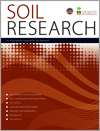Guest Editors
Nilantha Hulugalle (Australian National University)
Tapas K. Biswas (Australian National University and CSIRO)
Richard Greene (Australian National University)
Peter Bacon (Woodlots and Wetlands Pty Ltd)

Soil Research
Volume 59 Number 1 2021
Special IssueSoil: the Key to the Past, the Present and the Future
Soil pH within the surface 0.2 m of NSW agricultural land is stratified; commonly having higher pH in at the surface overlying acidic subsurface layers within 0.05–0.2 m. The cause of these layers is understood; however, the extent of acidic subsurface layers within agriculturally managed soils of NSW is unknown. Though direct amelioration of acidic layers is possible, preventative management of surface soil pH may be the most efficient means to address subsurface acidity.
 , Brian Murphy
, Brian Murphy  , Annette Cowie, Susan Orgill
, Annette Cowie, Susan Orgill  , Andrew Rawson, Aaron Simmons and Jason Crean
, Andrew Rawson, Aaron Simmons and Jason Crean
A pilot was developed to trial a market-based instrument to encourage farmers to change farm management to increase soil organic C (SOC). Farms successful in the pilot had lower initial SOC and were able to increase SOC stocks by establishing a permanent pasture or addition of organic amendments. The trial methods were consistent with the Australian Government’s current Measurement Method.
Recent studies indicate the potential of carbon sequestration in the subsoil, yet our understanding of how agricultural management impacts soil organic carbon (SOC) stocks is mostly limited to the topsoil. We found that agricultural management affected the topsoil and subsoil SOC dynamics differently, and the subsoil was more responsive to agricultural management than the topsoil in this cotton cropping system. Our study highlights the need to look beyond the topsoil to examine the impact of agricultural management on carbon sequestration.
Coastal wetlands such as mangrove and saltmarsh environments can store significant amounts of soil organic carbon (SOC). We assessed temperate saltmarsh and mangrove environments for SOC content and fractions in southern Australia. Saltmarsh sites generally had the highest SOC content in the surface layers, and mangrove sites had higher SOC content at depth.
All irrigation developments inherently carry a salinity risk, due to an unavoidable change in the water and salt balance. In this study, a salinity risk assessment utilising multiple methodological approaches identified irrigation-induced mobilisation of salt stores in the unsaturated zone and a connectivity between land management and salt discharges into the Condamine River. These results illustrate the requirement of any salinity risk assessment to identify and understand the hydrogeological interactions in the regolith.
Minimising emission of the potent greenhouse gas nitrous oxide from commercial orchards is increasingly important. This study examines different timings of application of nitrate fertiliser, a very significant source of nitrous oxide, in a commercial cherry orchard in Tasmania. Emissions were related to rainfall but also the timing of fertiliser application, this information being important to growers aiming to maximise production while minimising pollution.
Crop yields in the dryland areas of Aceh, Indonesia, are low and are contributing to rural poverty. Our study identified soil-based constraints to crop production – most cropping soils in the area had low fertility levels due to low carbon, nitrogen and basic cation contents. Some soils were acidic with a toxic level of aluminium and deficient in phosphorus. To sustainably increase crop yields, these soils need lime where acidic, fertilisers for nutrients and stable carbon-rich amendments for system stability.
Reintroducing conventional tillage (CT) in no-till (NT) cropping systems can control herbicide-resistant weeds, but adversely affect soil-pore and root architecture and ultimately belowground soil carbon. Soil structural and root characteristic changes related to tillage shift were quantified with micro X-ray computed tomography (μXCT). There was no significant impact on belowground soil total C. However, soil-pore and root geometry were significantly higher for CT compared with NT. These conditions necessitate the use of advanced technologies like μXCT to quantify changes in soil structure.
Substantial increase in agricultural lime use in WA has failed to ameliorate subsoil acidity, costing AU$0.5–1.6 billion annually. We investigated the slow improvement in subsoil acidity in response to surface liming in glasshouse and field experiments and found that a once-off ‘strategic tillage’ is a ‘quick fix’ for subsoil acidity. Development of cost-effective strategic tillage practices for integrating the management of soil with multiple constraints (subsoil acidity, compaction and hydrophobicity) will increase return on investment and improve soil condition.
SR19329 Abstract | SR19329 Full Text | SR19329PDF (1.6 MB) Open Access Article
Bulk density and soil stiffness moduli are essential parameters related to soil compaction, porosity, penetration resistance and structural integrity, and they govern the rate of root penetrability and seed germination. Conventional methods for measuring soil density and stiffness moduli are complex, destructive, time-consuming and often require skilled operators to conduct the tests. Piezoelectric sensors appear to be a rapid, cost-effective and convenient tool for accurately determining bulk density and stiffness of soil at very low strain levels.